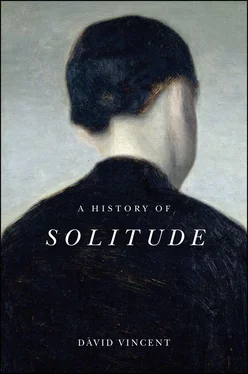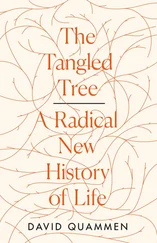At the same time, lower-case solitude remains a neglected topic in its own right. From Robert Bloomfield to our own era, opportunities for casual withdrawal from company have been sought and enjoyed. In his Solitude: A Philosophical Encounter , Philip Koch writes that, ‘One of the most fervently celebrated virtues of solitude is its ability to provide a place of refuge from the beleaguered toils of social life.’ 118These may take the form of extended leaves of absence from daily rituals, but more often they are borrowed moments from pressured lives. For most of the population most of the time, solitude has been a snatched experience found in contexts where company and its absence are equal and overlapping possibilities. This will be the central concern of Chapter 3on the nineteenth century, and Chapter 5on the twentieth and early twenty-first centuries. Whilst the latter-day advocates of monasticism and long-term retreats who will be discussed in Chapter 6sometimes presented the practices as a form of spiritual base-jumping, risking sanity in a high-risk encounter with prolonged silence and self-examination, the more general pattern has been to embrace solitude simply as a form of relaxation from work and family. In the words of Diana Senechal’s Republic of Noise , ‘Solitude contains great leisure. To be in solitude is to rest, even momentarily, from meeting the demands of others.’ 119
There is a need for what might be termed a quiet history of British society. Too little attention has been paid to the intermittently organized, often silent, re-creative practices that have been and remain a vital presence in the lives of most men and women in the modern world. Ira Cohen’s Solitary Action: Acting on Our Own in Everyday Life catalogues the ‘numerous … public sites where we find people engaged in solitary activities’, together with ‘our homes, where at various times of the day individuals find themselves alone or claim zones of solitude in order to do some housework or homework or recreate by themselves’, and observes that ‘this hitherto half-hidden realm of human behaviour’ is ‘a suitable subject for sociological enquiry’. 120What is true of the present applies also to the past. Social historians, like social scientists more generally, have tended to focus on communal, noisy forms of activity. This is partly from a desire to emphasize the complexity of interactions at all levels of society and not just amongst the educated and privileged. It is partly from a sense that collective practices have been the locus of historical change. And it is also a matter of evidence. Bloomfield’s farm boy enjoying his ‘frequent intervals of lonely ease’ left no mark on the public record, neither did the weary housewife stepping outside the house for a few moments of private peace. Even where historians have stooped to consider the pastimes of the common people, the tendency has been to concentrate on rough sports and commercialized mass entertainment which one way or another generated a trail of commentary and paperwork. 121
There are, however, a number of historical sources which between them permit the creation of at least a patchwork quiet history. A fertile archive was generated by the continual expansion of networked solitude. As we shall see in the next two chapters, from the beginning of the period covered by this study, solitary pastimes called forth a literature of periodicals and monographs which serviced isolated practices. A year after Zimmermann’s treatise first appeared in English, The Sporting Magazine began publication, carrying, amongst much else, information on long-distance solo walking against the clock, a popular constituent of the vibrant gambling culture of the era. 122From the late eighteenth century through to the present day, the energetic and responsive publishing industry produced material on a proliferating range of private pastimes. Alongside these there were monographs on the most salient quiet recreations, such as fishing and gardening, although these infrequently addressed the breadth of popular participation. From the last quarter of the nineteenth century, practitioners of all kinds of unseen hobbies, from embroidery to stamp collecting, began to form themselves into associations which created their own archives and publications. During the more recent past, oral histories and social surveys have extended their scope to examine the quotidian lives of the mass of the population. Finally there are the commentators from within the everyday world in the form of memoirs and imaginative literature. A champion of Robert Bloomfield was John Clare, one of the very few writers of his own or any subsequent period capable of engaging with both upper- and lower-case solitude, and his poetry and prose will form the point of departure for the next chapter.
In Zimmermann’s critical universe, solitude, for good or ill, was consciously practised by only a small minority of the population. The most striking change over the modern period was the expansion of the numbers of men and women who deliberately set aside time for themselves in the absence of company. Their behaviour was testament both to the growing demand for restorative withdrawal and the sustaining influence of material and communicative resources. As Chapters 7and 8will argue, persisting and in some cases deepening domestic poverty in the era of late modernity, together with growing disinvestment in public services, threatened to reverse these changes, generating a sense of crisis about the pathology of failed solitude in the form of loneliness. At the same time, the digital revolution in the last few years of this study seems likely to cause a significant disruption of the established patterns of networked solitude. Critical solitude, the search for alternative forms of spiritual truth in the face of corrupting social relations, had a fierce energy throughout this period, driven by the accelerating movement of the population from the countryside to the towns. But as will be discussed in Chapter 6, there were growing difficulties in maintaining the authority of the Christian retreat and the sanctity of nature as a refuge from urban civilization. The demand persisted, but in an increasingly diffuse and personalized form.
The posthumous life of Solitude Considered travelled far from its origins. ‘Zimmerman on Solitude’ became a cultural object in its own right, largely independent of the full text. 123During the course of the nineteenth century, it was treated as a shorthand for an uncritical endorsement of the subject. A young man or woman seeking to be considered serious and soulful would like to be seen with a copy as they walked in the countryside or found space for quiet reading at home. As with other literary successes, it enjoyed an existence in diverse recreational forms, including, in this case, horse racing. In March 1845, Mr Wesley’s three-year-old ‘Solitude by Zimmerman’ was entered for the Tally-Ho Stakes at the Northampton and Pytchley Hunt. It set off at a great pace, but at the first turn the horse bolted, leaving its rival, ‘D’Egville’, to build up a lead of three hundred yards. 124Eventually the rider regained control of his steed. The newspaper report concluded: ‘Solitude, however, made up for lost time on coming up the flat, and was only beaten by about three lengths.’ 125
1 1. The Gentleman’s Magazine, LXI, 2 (1791): 1215.
2 2. George S. Rousseau, ‘Science, Culture and the Imagination: Enlightenment Configurations’, in The Cambridge History of Science, Vol. 4, ed. Roy Porter (Cambridge: Cambridge University Press, 2003), 768.
3 3. Jay MacPherson, The Spirit of Solitude: Conventions and Continuities in Late Romance (New Haven: Yale University Press, 1982), 56. English editions of Zimmermann’s writings, and subsequent discussions of his work, freely anglicized his name to ‘Zimmerman’. This text uses his Swiss-German name, although the references and quotations will, where appropriate, keep the spelling adopted by a publisher or commentator.
Читать дальше












